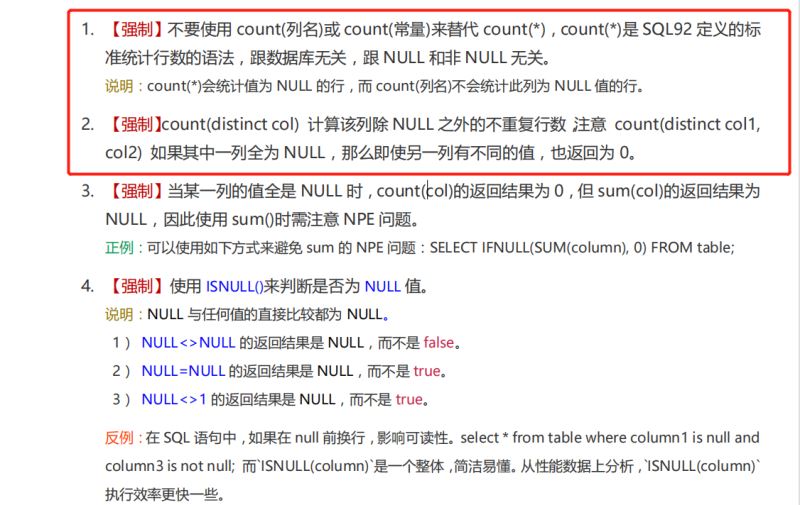MySql统计函数COUNT的具体使用详解
来源:脚本之家
时间:2022-12-31 10:14:53 303浏览 收藏
本篇文章给大家分享《MySql统计函数COUNT的具体使用详解》,覆盖了数据库的常见基础知识,其实一个语言的全部知识点一篇文章是不可能说完的,但希望通过这些问题,让读者对自己的掌握程度有一定的认识(B 数),从而弥补自己的不足,更好的掌握它。
1. COUNT()函数概述
COUNT() 是一个聚合函数,返回指定匹配条件的行数。开发中常用来统计表中数据,全部数据,不为NULL数据,或者去重数据。
2. COUNT()参数说明
COUNT(1):统计不为NULL 的记录。
COUNT(*):统计所有的记录(包括NULL)。
COUNT(字段):统计该"字段"不为NULL 的记录。
1.如果这个字段是定义为not null的话,一行行地从记录里面读出这个字段,判断不能为null,按行累加。
2.如果这个字段定义允许为null的话,判断到有可能是null,还要把值取出来在判断一下,不是null才累加。
COUNT(DISTINCT 字段):统计该"字段"去重且不为NULL 的记录。
-- MySql统计函数count测试 -- 创建用户表,新增测试数据 CREATE TABLE `user` ( `id` bigint(20) unsigned NOT NULL AUTO_INCREMENT COMMENT 'ID主键', `name` varchar(64) DEFAULT NULL COMMENT '姓名', `sex` varchar(8) DEFAULT NULL COMMENT '性别', `age` int(4) DEFAULT NULL COMMENT '年龄', `born` date DEFAULT NULL COMMENT '出生日期', PRIMARY KEY (`id`) ) ENGINE=InnoDB DEFAULT CHARSET=utf8mb4 ROW_FORMAT=DYNAMIC COMMENT='用户表'; INSERT INTO `category`.`user`(`id`, `name`, `sex`, `age`, `born`) VALUES (1, '%张三%', '男', 22, '2022-04-22'); INSERT INTO `category`.`user`(`id`, `name`, `sex`, `age`, `born`) VALUES (2, '李四', '女', 12, '2022-04-01'); INSERT INTO `category`.`user`(`id`, `name`, `sex`, `age`, `born`) VALUES (3, '王小二', '女', 12, '2022-04-28'); INSERT INTO `category`.`user`(`id`, `name`, `sex`, `age`, `born`) VALUES (4, '赵四', '男', 23, '2022-04-28'); INSERT INTO `category`.`user`(`id`, `name`, `sex`, `age`, `born`) VALUES (5, '', '女', 23, '2022-04-28'); INSERT INTO `category`.`user`(`id`, `name`, `sex`, `age`, `born`) VALUES (6, NULL, '女', 60, '2022-04-28'); INSERT INTO `category`.`user`(`id`, `name`, `sex`, `age`, `born`) VALUES (7, NULL, '女', 61, '2022-04-28'); select * from user; -- 统计数据:7条数据,统计所有的记录(包括NULL)。 select count(*) from user; -- 统计数据:7条数据,统计不为NULL 的记录。 select count(1) from user; -- 统计数据:5条数据,COUNT(字段):统计该"字段"不为NULL 的记录,注意是null不是空''字符串 select count(name) from user; -- 统计数据:5条数据,COUNT(DISTINCT 字段):统计该"字段"去重且不为NULL 的记录。 select count(distinct name) from user;
3. COUNT()判断存在
SQL不再使用count,而是改用LIMIT 1,让数据库查询时遇到一条就返回,不要再继续查找还有多少条了,业务代码中直接判断是否非空即可。
select 1 from emp LIMIT 1;效率是最高的,尤其是需要limit限制行数,很容易忽略。
-- SQL查找是否"存在"
-- 员工表,存在则进行删除
drop table if EXISTS emp;
create table emp(
id int unsigned primary key auto_increment,
empno mediumint unsigned not null default 0,
empname varchar(20) not null default "",
job varchar(9) not null default "",
mgr mediumint unsigned not null default 0,
hiredate datetime not null,
sal decimal(7,2) not null,
comn decimal(7,2) not null,
depno mediumint unsigned not null default 0
);
-- 新增cehsi数据
测试数据:https://blog.csdn.net/m0_37583655/article/details/124385347
-- cahxun
select * from emp ;
-- 时间:1.082s,数据:5000000
explain select count(*) from emp;
id select_type table partitions type possible_keys key key_len ref rows filtered Extra
1 SIMPLE Select tables optimized away
-- 时间:1.129s,数据:5000000
explain select count(1) from emp;
id select_type table partitions type possible_keys key key_len ref rows filtered Extra
1 SIMPLE Select tables optimized away
-- 时间:1.695s,数据:5000000
explain select 1 from emp;
id select_type table partitions type possible_keys key key_len ref rows filtered Extra
1 SIMPLE emp idx_emp_depno 3 4981060 100.00 Using index
-- SQL不再使用count,而是改用LIMIT 1,让数据库查询时遇到一条就返回,不要再继续查找还有多少条了,业务代码中直接判断是否非空即可
-- 时间:0.001s,数据:5000000
explain select 1 from emp LIMIT 1;
id select_type table partitions type possible_keys key key_len ref rows filtered Extra
1 SIMPLE emp idx_emp_depno 3 4981060 100.00 Using index
4. COUNT()阿里开发规范
1.【强制】不要使用 count(列名)或 count(常量)来替代 count(),count()是 SQL92 定义的标 准统计行数的语法,跟数据库无关,跟 NULL 和非 NULL 无关. 说明:count(*)会统计值为 NULL 的行,而 count(列名)不会统计此列为 NULL 值的行.
2.【强制】count(distinct col) 计算该列除 NULL 之外的不重复行数,注意 count(distinct col1, col2) 如果其中一列全为 NULL,那么即使另一列有不同的值,也返回为 0.

到此这篇关于MySql统计函数COUNT的具体使用详解的文章就介绍到这了,更多相关MySql统计函数COUNT内容请搜索golang学习网以前的文章或继续浏览下面的相关文章希望大家以后多多支持golang学习网!
好了,本文到此结束,带大家了解了《MySql统计函数COUNT的具体使用详解》,希望本文对你有所帮助!关注golang学习网公众号,给大家分享更多数据库知识!
-
151 收藏
-
368 收藏
-
421 收藏
-
269 收藏
-
419 收藏
-
271 收藏
-
338 收藏
-
419 收藏
-
119 收藏
-
127 收藏
-
137 收藏
-
473 收藏
-
140 收藏
-
252 收藏
-
434 收藏
-
233 收藏
-
385 收藏
-

- 前端进阶之JavaScript设计模式
- 设计模式是开发人员在软件开发过程中面临一般问题时的解决方案,代表了最佳的实践。本课程的主打内容包括JS常见设计模式以及具体应用场景,打造一站式知识长龙服务,适合有JS基础的同学学习。
- 立即学习 543次学习
-

- GO语言核心编程课程
- 本课程采用真实案例,全面具体可落地,从理论到实践,一步一步将GO核心编程技术、编程思想、底层实现融会贯通,使学习者贴近时代脉搏,做IT互联网时代的弄潮儿。
- 立即学习 516次学习
-

- 简单聊聊mysql8与网络通信
- 如有问题加微信:Le-studyg;在课程中,我们将首先介绍MySQL8的新特性,包括性能优化、安全增强、新数据类型等,帮助学生快速熟悉MySQL8的最新功能。接着,我们将深入解析MySQL的网络通信机制,包括协议、连接管理、数据传输等,让
- 立即学习 500次学习
-

- JavaScript正则表达式基础与实战
- 在任何一门编程语言中,正则表达式,都是一项重要的知识,它提供了高效的字符串匹配与捕获机制,可以极大的简化程序设计。
- 立即学习 487次学习
-

- 从零制作响应式网站—Grid布局
- 本系列教程将展示从零制作一个假想的网络科技公司官网,分为导航,轮播,关于我们,成功案例,服务流程,团队介绍,数据部分,公司动态,底部信息等内容区块。网站整体采用CSSGrid布局,支持响应式,有流畅过渡和展现动画。
- 立即学习 485次学习
